Blechnum chambersii
Tindale Lance Water-fernRhizome erect to oblique, short. Fronds tufted, erect to spreading, firm in texture, 15–55 cm tall; sterile and fertile fronds dissimilar. Stipe short, pale to brown; scales few, shiny, very narrow. Sterile frond lamina lanceolate, widest near centre, reducing rapidly towards apex and more gradually towards base, once pinnate, dark green; pinnae close-set, forwardly curved, attached by broad bases, narrowly oblong, margins bluntly serrate, apices acute to rounded; lower pinnae much reduced in size, sometimes forming irregular wing on rachis. Fertile fronds flaccid, shorter than sterile fronds; pinnae numerous, separated, curved, very narrow. Sori covering underside of lamina on each side of midvein.
GleP, VVP, GipP, OtP, WaP, CVU, GGr, DunT, EGL, EGU, WPro, HSF, HNF, OtR, Strz, HFE, VAlp. Also SA, Qld, NSW, Tas. (including King Is.), Norfolk Is. New Zealand, Fiji. Usually found near creeks in shady, moist forests where it grows in erect tufts on the forest floor or among rocks, or with downward arching fronds on wet banks, fallen logs at the bases of tree-ferns.
The flaccid fertile fronds with fine pinnae and the sterile fronds with serrate, sessile pinnae are characteristic of B. chambersii.
Entwisle, T.J. (1994). Ferns and allied plants (Psilophyta, Lycopodiophyta, Polypodiophyta). In: Walsh, N.G.; Entwisle, T.J., Flora of Victoria Vol. 2, Ferns and Allied Plants, Conifers and Monocotyledons, pp. 13–111. Inkata Press, Melbourne.
 Spinning
Spinning



